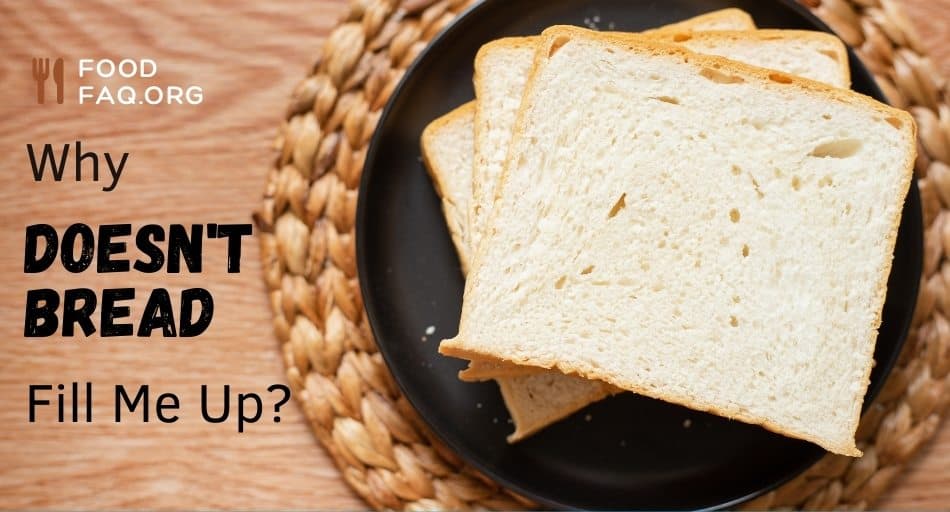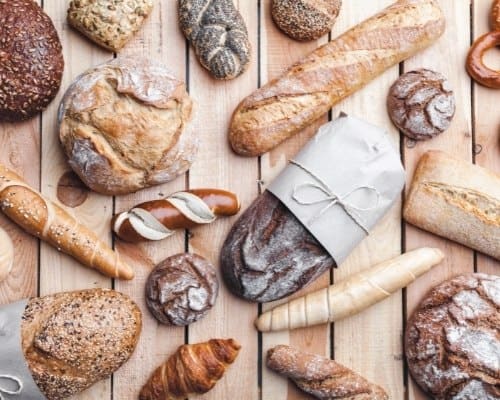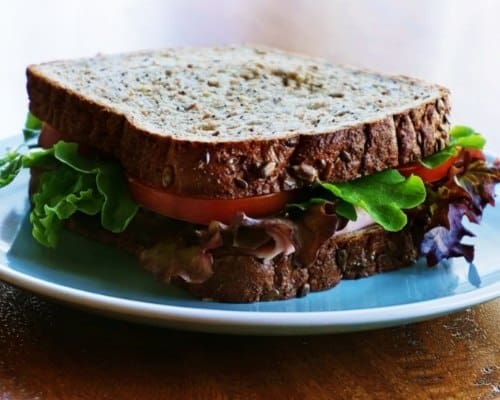If you ask people what they eat for breakfast, most of them will say that they have some type of bread. It makes sense: It’s affordable, delicious, and can be served with a wide variety of ingredients.

But have you ever noticed that you’re not full after eating bread, even though you’ve consumed a lot? Why is that happening?
Table of Contents
Why Doesn't Bread Fill Me Up?
Bread, especially commercially prepared white bread, contains mostly simple carbs. It’s also not very nutritionally balanced, making it a poor choice for a healthy diet. Because of that, if you love eating bread but find that it doesn’t fill you, it might be a good idea to ditch white bread and switch to other, more nutritious kinds, such as protein, whole-grain, or cornbread.
Is bread healthy?
The most widely consumed bread is white. This type of bread contains very few nutrients, making it a bad choice for a healthy, balanced diet.
It lacks a good amount of fiber and protein, which are two nutrients that help you stay full after a meal, preventing overeating and weight gain. Because of that, shortly after eating bread, you might find you’re hungry again.
Since white bread is low in fiber and other nutrients, it can mess with your microbiome, which is the colony of bacteria in your gut. Studies show that a diet low in fiber and whole grains is harmful to your gut bacteria, leading to acid reflux and other digestive system issues. As a result, white bread should be consumed rarely and replaced with high-fiber foods.
What’s more, most grains contain antinutrients, which are compounds that prevent your body from absorbing certain minerals, such as zinc, magnesium, and calcium. This is especially a problem for refined grains like white bread since they’re lower in vitamins and minerals than whole-grain, high-fiber bread.
Antinutrients shouldn’t be a problem for most people who otherwise follow healthy, balanced diets, but it’s always best to choose the healthiest choice, and white bread isn’t one.
Now that we’ve established that white bread isn’t particularly nutritious let’s talk about the healthier alternative: whole-grain bread. This kind tends to be higher in vitamins and minerals, including manganese, selenium, and niacin. These micronutrients help keep your digestive system healthy and even prevent other health conditions, such as cardiovascular issues.
Whole-grain and whole-wheat bread are also better at keeping your blood sugar levels steady. Doing so lowers your risk of type 2 diabetes, obesity, heart attack, and even high cholesterol levels.
The grains in white bread are usually stripped of these essential nutrients, which means that it doesn’t contain these beneficial compounds and substances.
Can you make bread more filling?

If you’re insistent on consuming white bread, there are some ways that you can make your morning slice healthier and more filling. One way to do so is to add healthy protein, such as ham, turkey, or chicken, on top of your sandwich, along with some healthy veggies like tomatoes or cucumbers. This mix of protein and fiber will help you feel full without eating too many slices of bread.
Another way you can make bread filling is by skipping sugary spreads like Nutella or other chocolate butter. These tend to cause spikes in your blood sugar levels and make you feel lethargic, especially if you eat too much of it.
Eating sugary foods also leads to craving more sugary foods, so it’s important to avoid them, especially early in the morning. If you like creamy spreads on your bread, it’s best to go for something higher in fiber and protein, such as almond or peanut butter instead.
The foolproof way of making your bread more filling is simply choosing whole-wheat or whole-grain options. This bread is higher in nutrients, including essential vitamins and minerals, and also contains more fiber.
Fiber helps you feel satisfied and full after the meal, which prevents overeating and keeps your energy levels up. Whole-grain bread also tends to be tastier than white bread due to all the seeds it contains.
Should you eat bread every day?

Overall, bread shouldn’t be considered a completely unhealthy food. It’s all about moderation and what you consume it with. For example, if you tend to eat white bread with a chocolate spread, it’s not good for your health.
But if you have a whole-grain bread slice with turkey ham instead, you can get some essential nutrients and stay full for a couple of hours. So, it all depends on how you prepare your sandwiches.
On the other hand, if you consume bread every day, you risk permanently raising your blood sugar levels, weight gain, and even cardiovascular issues. As mentioned before, white bread is low in fiber and other essential nutrients, so it doesn’t help you reach your dietary goals.
This, along with not filling you up, can also lead to inflammation of your digestive system, especially if you consume white bread every day.
Whole-grain bread has a different effect on your body, though. If you eat a whole-grain sandwich each morning, you provide your body with complex carbs and a good amount of fiber that help you stay full after eating for way longer than simple carbs do. If you pair that with some healthy protein, you can create a well-balanced breakfast that will keep you energized all morning.
Another great way to balance out eating bread is by consuming it only a few times a week. Other times you’re having breakfast or lunch, try switching it up and going for scrambled eggs, hard-boiled eggs, or even oatmeal.
Such meals provide you with a good amount of protein as well as fiber and various vitamins and minerals. That way, you’ll be able to safely consume bread from time to time without worrying about adverse side effects.
Even though bread is one of the most common breakfast foods, it’s not as healthy as you might think. White bread, in particular, is low in essential nutrients, including fiber, which makes it a poor choice for a healthy diet. But if you consume bread sparingly and as a part of a balanced dietary plan, you don’t have to eliminate this type of carb from your life completely.
Don't know what to drink? Check out these articles: 20 Most and Least Acidic Juices and 20+ Alcoholic Drinks Ranked by Acidity Level
